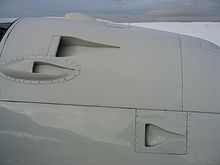NACA opening
A NACA opening is a streamlined air inlet in the outer skin of vehicles. The inclined edges generate air eddies that displace the slow boundary layer flow. Therefore it can be made small for a given air flow and increases the air resistance only slightly. The opening modeled flat in the outer skin was developed by the National Advisory Committee for Aeronautics (NACA) for the intake air of jet engines, but was only used for a few early jet aircraft . The powerful engines of supersonic aircraft need intake openings that are too large, which cannot be smoothly inserted into the surface of the fuselage.
In the automotive industry, the NACA opening was first used in racing cars and supplied cooling air or intake air for the engine. Later, from the mid-1960s, they were also used in production vehicles such as the Shelby Mustang , Alfa Romeo Montreal , Chevrolet Camaro Z28 and Porsche 924 Turbo .
In the early 1980s, NACA air intakes and air scoops were also offered as retrofit kits in the auto accessories market. These add-on parts often only served the sporty appearance.
literature
- Charles W. Frick, Wallace F. Davis, Lauros M. Randall, Emmet A. Mossmann: An Experimental Investigation of NACA Submerged-duct Entrances (= Advance Confidential Report . No. 5I20 ). National Advisory Committee for Aeronautics, Washington October 1945 (American English, 57 p., Cranfield.ac.uk [PDF; 12.6 MB ; accessed on July 23, 2016]).

